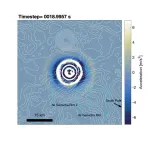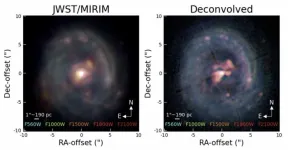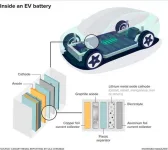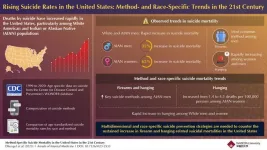(Press-News.org) Measuring the amount of precipitation that falls in a specific location is simple if that location has a device designed to accurately record and transmit precipitation data. In contrast, measuring the amount and type of precipitation that falls to Earth in every location is logistically quite difficult. Importantly, this information could provide a wealth of data for characterizing and predicting Earth’s water, energy and biogeochemical cycles. Researchers from China recently deployed a satellite, FengYun 3G (FY-3G), that is successfully collecting Earth precipitation data from space.
Scientists from the China Meteorological Administration developed and launched a satellite created to measure Earth precipitation with radar while orbiting in space. This is the first of two precipitation missions planned by the team to accurately measure the occurrence, type and intensity of any precipitation across the world, including over oceans and complex terrain. Specifically, the FY-3G satellite is designed to assess the 3-dimensional (3D) form of rainfall and other precipitation for weather systems at Earth’s middle and lower latitudes.
The team published their results in the 19 December 2023 issue of the Journal of Remote Sensing.
“The first active precipitation measurement satellite in China (FY-3G) was developed and successfully launched, and the commission test of the satellite platform and the instruments [was] completed, illustrating excellent performance. The active and passive microwave instruments combined with optical imaging instruments… obtain high-precision observation data of global precipitation. The satellite can also cooperate with the on-orbit Global Position Measurement (GPM) satellite to enhance the ability of scientists to study the structure and mechanism of global precipitation as well as carry out water cycle research,” said Peng Zhang, first author of the review paper and leading scientist of the FY-3 polar orbiting meteorological satellite program at the National Satellite Meteorological Center in Beijing, China.
FY-3G marks the first rainfall satellite mission from China and the third such mission in the world. The satellite can measure clouds, precipitation and atmospheric profiles with the complement of remote sensing instruments built into the satellite.
Specifically, the active remote sensing precipitation measurement radar (PMR) works in tandem with a passive microwave imager MWRI-RM, which has been optimized to improve the detection of weaker precipitation over land and solid forms of precipitation. An optical imaging instrument, the MERSI-RM, assists other microwave instruments in measuring clouds and precipitation to facilitate low-orbit precipitation measurement and high-orbit infrared precipitation estimation.
The GNOS-II instrument, also included on the satellite, uses variations in global navigation satellite system (GNSS) data to accurately measure temperature, humidity and sea surface speed from space. The FY-3G also houses an short-wave infrared polarized multi-angle imager (PMAI) and high radiometric accuracy on-board calibrator (HAOC).
As a precipitation measurement device, the primary instrument of the FY-3G satellite is the active precipitation measurement radar PMR, which creates a 3D rendering of falling precipitation. Data collected by the instrument can then be used to calculate precipitation intensity and type, improving the accuracy of measurements taken from space.
“China has successfully launched a precipitation measurement satellite [FY-3G], and the commission test results show that its measurement performance is superior, and high-precision 3D precipitation measurement information can be obtained. FY-3G and GPM can form a virtual constellation in orbit, which greatly enhances the ability to measure and study global precipitation. FY-3G global observation data are [freely available] to… worldwide users through the Fengyun Satellite Data Center,” said Zhang.
Importantly, FY-3G has improved our understanding of global precipitation, which will help scientists better interpret and predict our planet’s water and energy cycles. This data will be used to enhance forecasting of extreme weather events and inform the development of the program’s next generation precipitation satellite, FY-5.
The team is encouraged by the data they have received from FY-3G, but more data processing work is required to fully grasp the satellite’s capacity and future applications. “Next, we will accelerate the development of precipitation event database and precipitation data set based on FY-3G satellite data. We also plan to improve the quantitative inversion accuracy of active radar precipitation and strengthen the global data service of the FY-3G satellite. We will also continue to promote the follow-up satellite development plan to ensure continuous precipitation observation,” said Zhang.
Other contributors include Songyan Gu, Lin Chen, Jian Shang, Manyun Lin, Aijun Zhu, Honggang Yin, Qiong Wu, Yixuan Shou, Fenglin Sun, Hanlie Xu, Guanglin Yang, Haofei Wang, Lu Li, Sijie Chen and Naimeng Lu from the Key Laboratory of Radiometric Calibration and Validation for Environmental Satellites at the National Satellite Meteorological Center (National Center for Space Weather) from the China Meteorological Administration in Beijing, China and the Innovation Center for FengYun Meteorological Satellite in Beijing, China; and HongWei Zhang from the Shanghai Academy of Spaceflight Technology in Shanghai, China.
This work was supported by the FY3-03 meteorological satellite project ground application system and the International Space Water Cycle Observation Constellation Program (grant no. 183311KYSB20200015).
END
New satellite capable of measuring Earth precipitation from space
2024-01-25
ELSE PRESS RELEASES FROM THIS DATE:
Women exposed to toxic metals may experience earlier aging of their ovaries
2024-01-25
WASHINGTON—Middle-aged women who are exposed to toxic metals may have fewer eggs in their ovaries as they approach menopause, according to new research published in The Journal of Clinical Endocrinology & Metabolism.
Diminished ovarian reserve is when women have fewer eggs compared to others their age. The condition may be linked to health problems such as hot flashes, weak bones and a higher chance of heart disease.
Menopause is a normal part of the aging process a woman goes through that causes her monthly periods to end. The menopausal transition includes the years leading up to that point, when women may experience symptoms such as changes in ...
The moon is shrinking, causing landslides and instability in lunar south pole
2024-01-25
Earth’s moon shrank more than 150 feet in circumference as its core gradually cooled over the last few hundred million years. In much the same way a grape wrinkles when it shrinks down to a raisin, the moon also develops creases as it shrinks. But unlike the flexible skin on a grape, the moon’s surface is brittle, causing faults to form where sections of crust push against one another.
A team of scientists discovered evidence that this continuing shrinkage of the moon led to notable surface warping in its south polar ...
Icahn Mount Sinai School of Medicine receives Helmsley Charitable Trust grant for Crohn's disease research
2024-01-25
New York, NY [January 25, 2024]—The Icahn School of Medicine at Mount Sinai has been awarded a grant of more than $4 million from The Leona M. and Harry B. Helmsley Charitable Trust to support an innovative research project aimed at understanding the early stages of Crohn’s disease before noticeable symptoms develop.
Led by the Department of Genetics and Genomic Sciences along with the Dr. Henry D. Janowitz Division of Gastroenterology in the Department of Medicine at the Icahn School of ...
Sika deer overpopulation endangers beech forests in Southern Kyushu, Japan
2024-01-25
Fukuoka, Japan—Kyushu University researchers have found that Japanese beech (Fagus crenata) in the forests of southern Kyushu have seen reduced growth, due to soil erosion caused by the overpopulation of sika deer (Cervus nippon). Their findings, which were published in the journal Catena, could help in the development of new strategies for forest conservation.
Conservation is more than just preserving forests; it's about protecting the diverse web of life. One area where conservation has become critical is a beech forest in Shiiba Village, in the remote mountains of Southern Kyushu. The Japanese beech is a prominent and iconic species in ...
UTSA researchers reveal faint features in galaxy NGC 5728 though JWST image techniques
2024-01-25
(SAN ANTONIO, TEXAS) — Mason Leist is working remotely—127 million light-years from Earth—on images of a supermassive black hole in his office at the UTSA Department of Physics and Astronomy.
The UTSA Graduate Research Assistant led a study, published in The Astronomical Journal, on the best method to improve images obtained by the James Webb Science Telescope (JWST) using a mathematical approach called deconvolution. He was tasked by the Galactic Activity, Torus, and Outflow Survey (GATOS), an international team of scientists, to enhance JWST observations of the galaxy NGC 5728.
The GATOS team, co-led by UTSA Professor and Leist’s doctoral ...
Polymer power: Incheon National University researchers enhance the safety of lithium batteries
2024-01-25
Lithium-ion batteries are a widely used class of rechargeable batteries in today’s world. One of the processes that can hamper the functioning of these batteries is an internal short circuit caused by direct contact between the cathode and anode (the conductors that complete the circuit within a battery). To avoid this, separators composed of polyolefins—a type of polymer— can be employed to maintain separation. However, these separators can melt at higher temperatures, and the inadequate absorption of electrolytes (essential for conveying ...
Suicide and race: Uncovering patterns underlying increasing suicide rates in the USA
2024-01-25
Are there specific communities that bear the brunt of suicide mortality? Certain studies have revealed that historically marginalized and economically deprived indigenous populations are linked with higher rates of cluster suicides—especially in Canada, the United States, and Australia. Public health officials need to consider that the risk of suicide contagion—social transmission due to insufficient interventions and resources—is real and must be countered. Now, a consortium of public health experts from Japan, Australia, and China have analyzed trends in suicide mortality in American Indian or Alaskan Native (AIAN) populations, while exploring ...
Deep learning reveals molecular secrets of explosive perchlorate salts
2024-01-25
Perchlorates are a class of compounds that are notorious for their explosive nature. This raises safety concerns during experiments involving complex compounds that contain perchlorate ions, since explosions can be triggered even by the slightest shock or heat. It is, therefore, important to study their molecular structure and understand the reason behind their explosive nature.
In this context, a method called the Hirschfield surface analysis has been extensively used for visualizing and quantifying the crystal structure and molecular interactions of crystal compounds. Moreover, a two-dimensional fingerprint plot derived from the Hirschfield ...
National retailers support heart and stroke health through annual Life is Why™ campaign
2024-01-25
DALLAS, Jan. 25, 2024 — This February, during American Heart Month and the American Heart Association’s Centennial year, the Association is devoted to a world of healthier lives for all by teaming up with retailers and brands around the country for Life is Why™, a cause marketing campaign supporting the Association’s life-saving heart and brain health mission. Life is Why inspires consumers to celebrate their reasons to live healthier, longer lives and participate personally in the mission of the Association by donating at the point-of-sale or by purchasing a product ...
Permeable pavements could reduce coho-killing tire pollutants
2024-01-25
PUYALLUP, Wash. — The pore-like structure of permeable pavements may help protect coho salmon by preventing tire wear particles and related contaminants from entering stormwater runoff, according to a Washington State University study.
Researchers demonstrated that four types of permeable pavements can act as giant filters, retaining more than 96% of applied tire particle mass. They also captured several tire-associated chemicals, resulting in a 68% average reduction of 6PPD-quinone, a contaminant shown to kill coho salmon in urban streams. The study findings were published in the journal Science of the Total Environment.
“The pressure on existing stormwater management technologies ...







